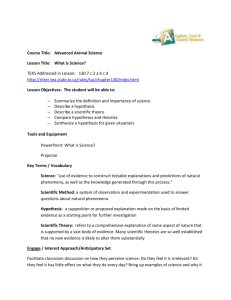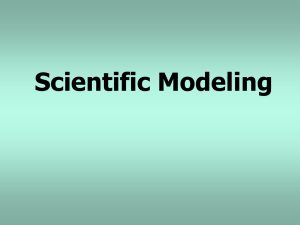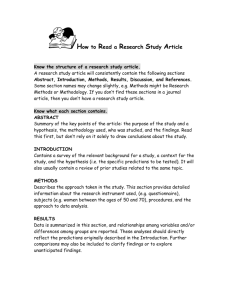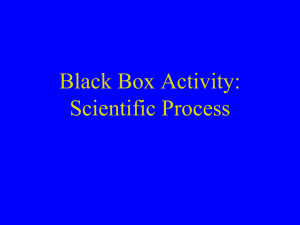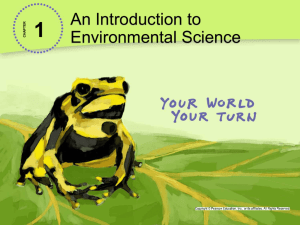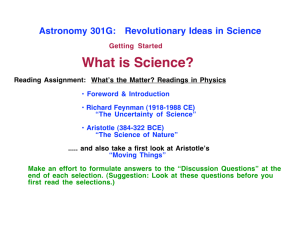General Science Glossary
advertisement
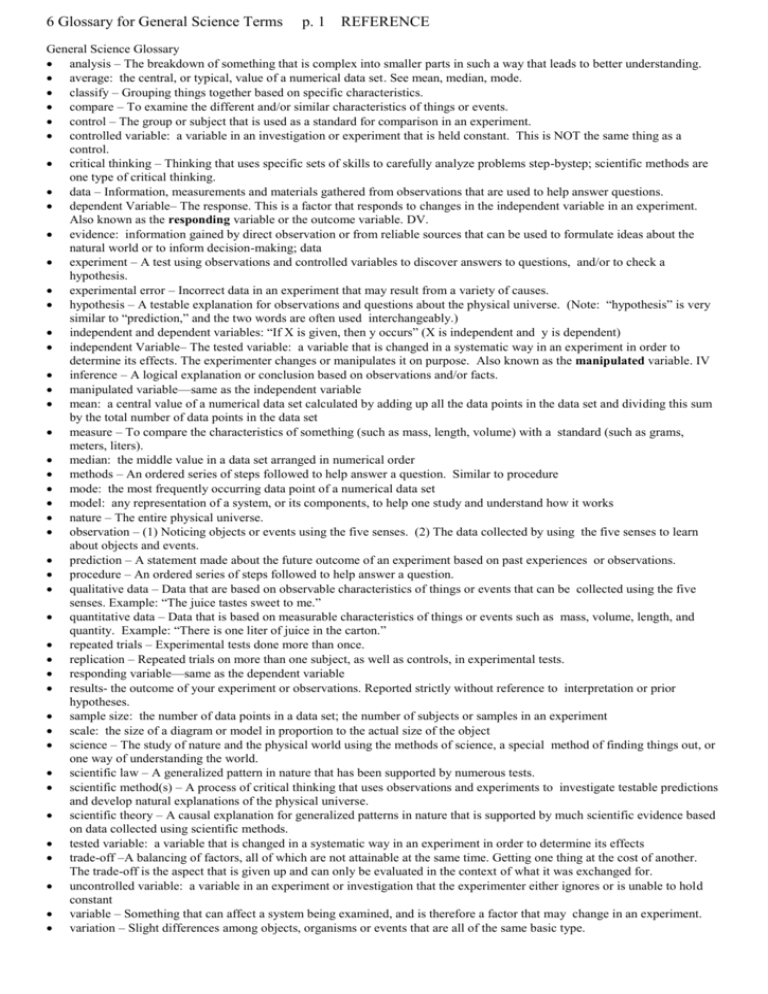
6 Glossary for General Science Terms p. 1 REFERENCE General Science Glossary analysis – The breakdown of something that is complex into smaller parts in such a way that leads to better understanding. average: the central, or typical, value of a numerical data set. See mean, median, mode. classify – Grouping things together based on specific characteristics. compare – To examine the different and/or similar characteristics of things or events. control – The group or subject that is used as a standard for comparison in an experiment. controlled variable: a variable in an investigation or experiment that is held constant. This is NOT the same thing as a control. critical thinking – Thinking that uses specific sets of skills to carefully analyze problems step-bystep; scientific methods are one type of critical thinking. data – Information, measurements and materials gathered from observations that are used to help answer questions. dependent Variable– The response. This is a factor that responds to changes in the independent variable in an experiment. Also known as the responding variable or the outcome variable. DV. evidence: information gained by direct observation or from reliable sources that can be used to formulate ideas about the natural world or to inform decision-making; data experiment – A test using observations and controlled variables to discover answers to questions, and/or to check a hypothesis. experimental error – Incorrect data in an experiment that may result from a variety of causes. hypothesis – A testable explanation for observations and questions about the physical universe. (Note: “hypothesis” is very similar to “prediction,” and the two words are often used interchangeably.) independent and dependent variables: “If X is given, then y occurs” (X is independent and y is dependent) independent Variable– The tested variable: a variable that is changed in a systematic way in an experiment in order to determine its effects. The experimenter changes or manipulates it on purpose. Also known as the manipulated variable. IV inference – A logical explanation or conclusion based on observations and/or facts. manipulated variable—same as the independent variable mean: a central value of a numerical data set calculated by adding up all the data points in the data set and dividing this sum by the total number of data points in the data set measure – To compare the characteristics of something (such as mass, length, volume) with a standard (such as grams, meters, liters). median: the middle value in a data set arranged in numerical order methods – An ordered series of steps followed to help answer a question. Similar to procedure mode: the most frequently occurring data point of a numerical data set model: any representation of a system, or its components, to help one study and understand how it works nature – The entire physical universe. observation – (1) Noticing objects or events using the five senses. (2) The data collected by using the five senses to learn about objects and events. prediction – A statement made about the future outcome of an experiment based on past experiences or observations. procedure – An ordered series of steps followed to help answer a question. qualitative data – Data that are based on observable characteristics of things or events that can be collected using the five senses. Example: “The juice tastes sweet to me.” quantitative data – Data that is based on measurable characteristics of things or events such as mass, volume, length, and quantity. Example: “There is one liter of juice in the carton.” repeated trials – Experimental tests done more than once. replication – Repeated trials on more than one subject, as well as controls, in experimental tests. responding variable—same as the dependent variable results- the outcome of your experiment or observations. Reported strictly without reference to interpretation or prior hypotheses. sample size: the number of data points in a data set; the number of subjects or samples in an experiment scale: the size of a diagram or model in proportion to the actual size of the object science – The study of nature and the physical world using the methods of science, a special method of finding things out, or one way of understanding the world. scientific law – A generalized pattern in nature that has been supported by numerous tests. scientific method(s) – A process of critical thinking that uses observations and experiments to investigate testable predictions and develop natural explanations of the physical universe. scientific theory – A causal explanation for generalized patterns in nature that is supported by much scientific evidence based on data collected using scientific methods. tested variable: a variable that is changed in a systematic way in an experiment in order to determine its effects trade-off –A balancing of factors, all of which are not attainable at the same time. Getting one thing at the cost of another. The trade-off is the aspect that is given up and can only be evaluated in the context of what it was exchanged for. uncontrolled variable: a variable in an experiment or investigation that the experimenter either ignores or is unable to hold constant variable – Something that can affect a system being examined, and is therefore a factor that may change in an experiment. variation – Slight differences among objects, organisms or events that are all of the same basic type. 6 Glossary for General Science Terms p. 2 REFERENCE Knowledge—How We Know There is no such thing as "certainty" in science. Observations and Experiments: Anything you see, hear, smell, taste, or touch, with or without special instruments, is an observation. Observations can be wrong. Science begins with observations of nature. Thus Galileo began his study of falling bodies not by making general statements, but by observing. Anything you see, hear, smell, taste, or touch is an observation. An observation may be quite casual - "You are wearing a blue shirt" - or it may be quite formal and planned. Formal, carefully planned and executed experiments are designed to make observations. (Actually, experimental data are observations. Scientists also draw conclusions from experiments.) Fact: When an observation is confirmed repeatedly and by many independent and competent observers, it can become a fact. Hypothesis: A testable statement about the natural world that can be used to build more complex inferences and explanations. If an hypothesis that describes how nature works survives many experimental tests or observations, it may become a law. Law: A descriptive generalization about how some aspect of the natural world behaves under stated circumstances. A scientific law (sometimes called a principle) is a powerful summary of many previously unrelated facts. (E.g., Newton's Law of Gravitation, 1687) Theory: An extremely well-substantiated explanation of some aspects of the natural world that incorporates facts, laws, predictions, and tested hypotheses. (E.g., Einstein's Theory of Gravitation, 1916) Scientific Method—How we find out Scientific Method: Principles and procedures for the systematic pursuit of knowledge about natural phenomena, involving the recognition and formulation of a problem, the collection of data through observation and experiment, and the formulation and testing of hypotheses. The scientific method may be described as consisting of four steps: Observation and description of a phenomenon or a group of related phenomena. When an investigator has little prior information, the first step is often description. Formulation of a testable hypothesis to explain the phenomena. Investigators may speculate about which variables might be related to other variables and in what manner. The hypothesis is often a statement about the relationship between or among variables; it may merely ask whether a connection exists (correlational research), or whether there is a cause-and-effect relationship. Prediction of the existence of other phenomena using the hypothesis, or of the results of future observations. Conducting experiments and observations by several independent experimenters who use proper experimental methods and represent mainstream peer review. Inquiry Basic Skills of Scientific Inquiry include: Asking the right question; Observing Classifying and sequencing; Communicating; Measuring; Predicting; Hypothesizing; Inferring; Defining, controlling, and manipulating variables in experimentation; Designing, constructing and interpreting models; Interpreting, analyzing and evaluating data. Uses of Scientific Inquiry: Making connections with world situations; Encouraging more active problemsolving approach to learning and thinking; Applying math skills; Reviewing what is already known in light of experimental evidence; Proposing answers, explanations and predictions; Using tools to gather, analyze and interpret data Modeling A scientific model is an idea that allows us to create explanations of how we think some part of the world works. An important model was that of the atom, in which there were subatomic particles (protons and neutrons) in a nucleus and electrons (organized into electron shells) that orbit the nucleus. This model of the atom allows scientists to explain why certain atoms (or molecules) combine in the ways that they do and to make predictions about which atoms (or molecules) will or won't combine when brought into contact. Protons, neutrons, and electrons, in this sense, are not necessarily real in the way that basketballs are. Rather, they are ideas that humans have developed to help explain what we see and to make predictions about what may yet be seen. They are invented by scientists. Have you ever put together a model airplane? Certainly you've played with toy cars. Both of these are "models" in the sense that they faithfully represent certain aspects of the real, full-size object (the overall shape, for instance) while ignoring others (the size, the way the engines function - or don't function - in the model). When scientists create a model, they pick and choose what aspects contribute most to its behavior. They say what they are including in the model, and also what they are leaving out that may be significant, but may be too difficult to detect or measure. With computers, we can create "virtual models," or simulations. Using mathematical formulas to mimic the behavior of as many phenomena as possible, we can run many scenarios of real-life phenomena rapidly, and often inexpensively.


